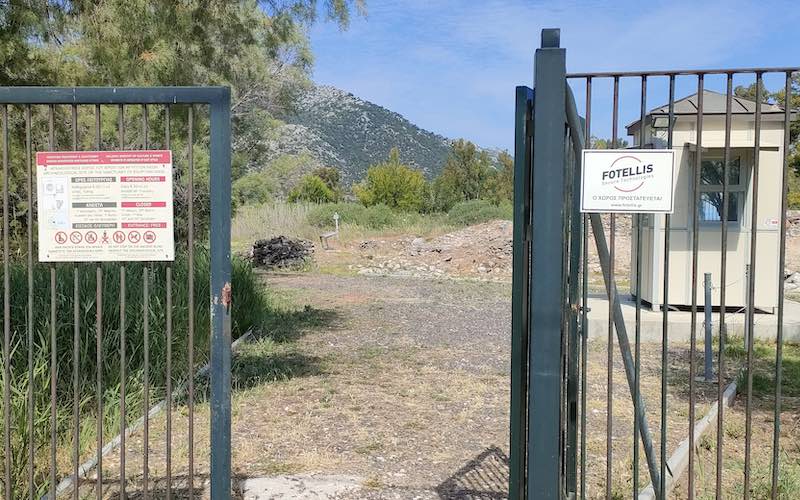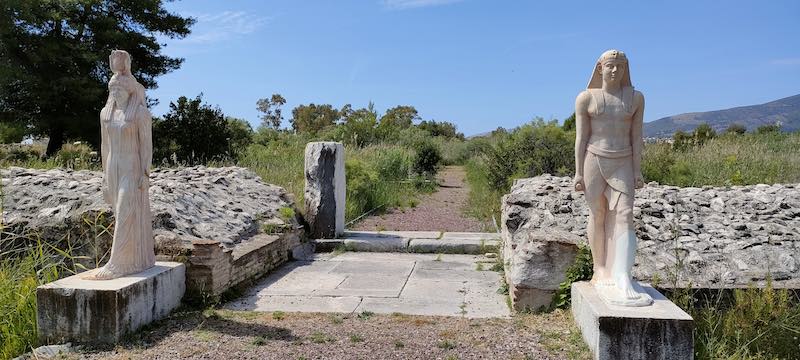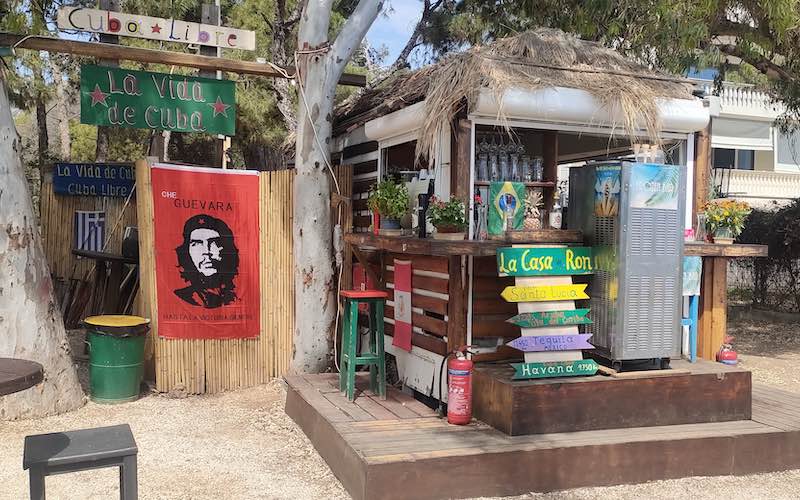When you think about Greece and Greek history, you imagine the Greek monuments such as the Parthenon and the temple of Zeus. It may surprise you to hear that there is actually a sanctuary of the Egyptian Gods in Nea Makri, which lies on the coast to the East of Athens, the Greek Capital. Interestingly, I learnt that the worship of Egyptian Gods filtered through to other countries (including Greece) in the ancient world. I decided to take a trip to the Sanctuary of the Egyptian Gods to check it out!
Ancient Egyptian connections with Greece
It’s worth noting that ancient Greece had cultural and trade connections with Egypt, and there may have been some influence of Egyptian religious practices in certain areas. In various parts of Greece, including Athens, there have been archaeological discoveries of Egyptian artefacts and influences, indicating the presence and integration of Egyptian culture and religious practices in the ancient world. It is these influences which mean that places such as the Sanctuary of the Egyptian Gods sprung up in Brexiza (Attica).
History of the Sanctuary of the Egyptian Gods
The Sanctuary complex was founded by Herodes Atticus, around 160 AD. He was a great orator, sophist and benefactor from Marathon and resided here – the complex was possibly established within his estate (see http://odysseus.culture.gr/h/3/eh351.jsp?obj_id=19842 for more history).
Is the Sanctuary of the Egyptian Gods in Nea Makri Worth visiting
I would say that the Sanctuary of the Egyptian Gods is worth visiting if you have some spare time in Nea Makri and have an interest in archaeology. I found it to be peaceful and very interesting and it is definitely worth it if you have two or three days in the area. I wouldn’t however, sacrifice a day in Athens for the Nea Makri Sanctuary of the Egyptian Gods – make sure that you prioritise a day in Athens first (the monuments there are so massive and spectacular). The Sanctuary of the Egyptian Gods is only a ruin, and the statues there are replicas as the originals have been taken to the archaeological museum.
You only need about 15-20 minutes to see it and so it’s nice to visit if you are walking along the coast. Make sure that you are appropriately dressed – it is not allowed to visit it in beachwear or swimming costumes/shorts.
Visiting the Sanctuary of the Egyptian Gods
You can actually walk to the Sanctuary of the Egyptian Gods from Nea Makri town – it’s a pleasant coastal walk which will take you around 20 minutes. You can also get there in about ten minutes by taxi (Uber and Free Now both work in Nea Makri – download the Uber app here). From the coast, it is a little bit tucked away, but you will see the gate in the wire fence.

At the time of writing (2023) the entrance was free. There was a woman in a booth at the entrance for information, but she was not selling tickets. Remember that the sanctuary is closed on Tuesdays.
What is the Sanctuary of the Egyptian Gods in Brexiza?
These Egyptian statues appear to be in the middle of nowhere….standing at the entrance to the sanctuary. According to an inscription, it was said to be dedicated to Sarapi – a hellenised form of the Egyptian God of Osiris. Festivals of Isis and Sarapi were celebrated here and their son Horus was also worshipped. Many statues are unfortunately copies or covered up as the best ones are in the Archaeological museum.
The information below has been taken from the information boards at the site – you do not need a guide here as there is sufficient information available and the site is quite small.
Roman Baths (Balneaum)
Walk forward as you enter and you will see the remains of Egyptian baths founded by Herodes Atticus in the Mikro Elos (Small Marsh) of Brexiza in around 160 AD. The bath house was in operation until the 4th Century. They were provincial bathhouses used for socialising as well as bathing. Most Roman baths had a changing room and three baths which would have been cold (frigidarium), tepid (tepidarium) and warm (caladium). At this bathhouse, it seems that there was a central bath for warm bathing with an elliptical marble lined pool. Around it, there are eighteen chambers, two circular rooms for bathing, two hexagonal rooms for tepid baths, other smaller rooms for cold bathing, a changing room and additional servicing/auxiliary rooms. The excavation of this bathhouse has still not been completed, and it is unsure as to whether the entrance was on the seaward side or the North side by the sanctuary.

The main Sanctuary
The sanctuary comprises the large rectangular area of the sanctuary proper to the west and of a forecourt to the east. The sanctuary is enclosed by a wall (60.50×64.60 m) with four entrances, one on each side. The entrances imitate Egyptian pylons; they are framed by two rectangular towers, between which marble steps and a threshold are preserved.
Each entrance is flanked inside and out by pairs of colossal statues set on pedestals, one male in the type of the Pharaoh statues, and the other female representing the goddess Isis in different types e.g. as Isis-Demeter holding ears of wheat or Isis-Aphrodite holding roses. Three pairs of statues have survived, exhibited in the in Archaeological Museum of Marathon, as well as marble pedestals. Replicas of the statues stand on their respective bases, at the site.

Paved causeways led from the four pylons to the centre of the sanctuary, where a stepped construction dominates, set upon a rectangular terrace. The terrace, in its turn, was surrounded by a passageway. On the outside of the passage, at the mid-point of each side, the paved causeways terminate in four steps and an elevated platform.
Subsidiary Rooms
Each platform is flanked by two rooms, probably of subsidiary use. In two of these rooms there have been found a statue of Isis, an Egyptian Sphinx, enormous lamps with relief busts of Sarapis and Isis as well as marble falcons symbolising the god Horus.

Eastern Courtyard and Portico
A large courtyard is formed outside of the Eastern pillar, which is surrounded by a Portico on three sides.
Egyptian gods had been gradually adopted by the Greeks since the last decades of the 4th century BC and constantly gained ground. The nature of Isis was in tune with Greek beliefs, resulting in her identification with Greek deities.
What to see nearby
Next to the Sanctuary you can find a small Greek Orthodox Church which is free to visit (be respectful and dress conservatively as it is an active place of worship). There are also some lovely beaches and beach bars nearby on the walk back to Nea Makri (one of my favourite Nea Makri beach bars is Cuba Libre).

Further Reading on Nea Makri and Athens
If you enjoyed this blog on the Sanctuary of the Egyptian Gods, you might also like to read about:
- Things to do in Nea Makri
- Is Athens worth visiting?
- St Ephraim of Nea Makri – A beautiful Greek Orthodox Monastery
- How to spend one day in Athens

